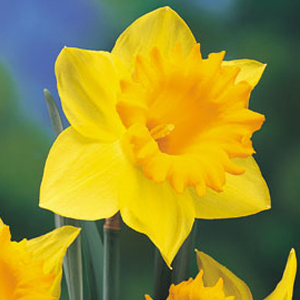


Daffodils are one of the easiest to grow and most popular spring flowers. With over 50 species coming in all sizes, there is a daffodil for every garden. The traditional daffodil can be either yellow or white with six petals and a trumpet-shaped central corona. They have a leafless stem that can bear between 1 and 20 flowers. Planted in fall or early spring, suitable for planting between shrubs or in a border. They look great in a garden or in large groves and can be even planted inside or used as cut flowers. These flowers are long-living perennial plants that will add beauty to your garden for many years.
Location
Daffodils bloom best in full sun or partial shade. Choose a site with lots of sun and well-drained soil. You can also work in a few inches of compost into the soil before planting for an added boost. Daffodil bulbs love being planted in a grove, near a mailbox, as splashes of color in garden beds, or as colorful borders.
Soil
Daffodils tolerate a range of soils, but grow best in fertile, well-drained soil. When planting, most varieties prefer neutral to slightly acidic soil (pH 6.0-7.0). As with most bulbs, you’ll want an area with excellent drainage or they will rot. Daffodils can survive for years, so choose a spot with soil that will allow them to thrive. Choose soil with a lot of organic matter. If you want, you can add organic bulb fertilizer right into the planting hole to assist with their growth.
Water
Daffodils need a lot of water while they are growing, so it is important that your well-drained soil is kept moist during the growing season. Daffodils need about an inch of water per week while they are actively growing and blooming (March-May). To help conserve moisture, add a layer of mulch to your garden bed. They like to be watered regularly in the spring and fall, but go dormant in the summer and prefer drier soil Stop watering about 3-4 weeks after the flowers fade.
Fall Planting
Daffodils are planted in the fall, about 2 to 4 weeks before the ground freezes. Select high-quality bulbs that have not dried out. The larger the bulb, the better. When planting bulbs, plant them pointed end up. They should be 2 or 3 times as deep as they are wide. There should be at least three inches of soil covering the bulb during the freezing winter months. They will tolerate some crowding, but daffodils prefer to be spaced 2-6 inches apart. However, plant generously in case some do not sprout and space them randomly for a more natural appearance. If you want groves of daffodils or full landscapes, be prepared to buy and plant a large quality of bulbs. Water well after planting and apply mulch to keep the weeds down and hold moisture.
Care Tips
For a neater appearance, dehead plants as the flowers fade but leave the leaves for at least 6 weeks. Only cut the foliage after it begins to turn yellow (Late May or June). Allow the plants to grow until they die off. The energy they store after blooming is helpful for next year’s blooms. If you want, you can dig them up. Wash the bulbs thoroughly and let them dry completely (at least a week). Then you can put them in onion sacks or pantyhose and hang them in the coolest place you can find until they are ready to plant. Good air circulation will keep the storage rot at a minimum.